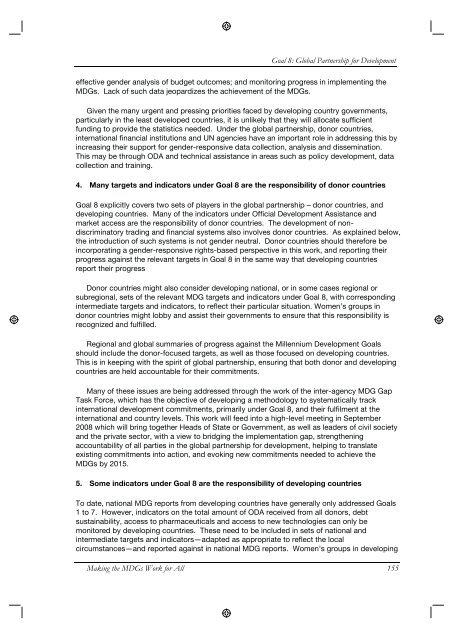Goal 8 - CEDAW Southeast Asia
Goal 8 - CEDAW Southeast Asia
Goal 8 - CEDAW Southeast Asia
You also want an ePaper? Increase the reach of your titles
YUMPU automatically turns print PDFs into web optimized ePapers that Google loves.
<strong>Goal</strong> 8: Global Partnership for Development<br />
effective gender analysis of budget outcomes; and monitoring progress in implementing the<br />
MDGs. Lack of such data jeopardizes the achievement of the MDGs.<br />
Given the many urgent and pressing priorities faced by developing country governments,<br />
particularly in the least developed countries, it is unlikely that they will allocate sufficient<br />
funding to provide the statistics needed. Under the global partnership, donor countries,<br />
international financial institutions and UN agencies have an important role in addressing this by<br />
increasing their support for gender-responsive data collection, analysis and dissemination.<br />
This may be through ODA and technical assistance in areas such as policy development, data<br />
collection and training.<br />
4. Many targets and indicators under <strong>Goal</strong> 8 are the responsibility of donor countries<br />
<strong>Goal</strong> 8 explicitly covers two sets of players in the global partnership – donor countries, and<br />
developing countries. Many of the indicators under Official Development Assistance and<br />
market access are the responsibility of donor countries. The development of nondiscriminatory<br />
trading and financial systems also involves donor countries. As explained below,<br />
the introduction of such systems is not gender neutral. Donor countries should therefore be<br />
incorporating a gender-responsive rights-based perspective in this work, and reporting their<br />
progress against the relevant targets in <strong>Goal</strong> 8 in the same way that developing countries<br />
report their progress<br />
Donor countries might also consider developing national, or in some cases regional or<br />
subregional, sets of the relevant MDG targets and indicators under <strong>Goal</strong> 8, with corresponding<br />
intermediate targets and indicators, to reflect their particular situation. Women’s groups in<br />
donor countries might lobby and assist their governments to ensure that this responsibility is<br />
recognized and fulfilled.<br />
Regional and global summaries of progress against the Millennium Development <strong>Goal</strong>s<br />
should include the donor-focused targets, as well as those focused on developing countries.<br />
This is in keeping with the spirit of global partnership, ensuring that both donor and developing<br />
countries are held accountable for their commitments.<br />
Many of these issues are being addressed through the work of the inter-agency MDG Gap<br />
Task Force, which has the objective of developing a methodology to systematically track<br />
international development commitments, primarily under <strong>Goal</strong> 8, and their fulfilment at the<br />
international and country levels. This work will feed into a high-level meeting in September<br />
2008 which will bring together Heads of State or Government, as well as leaders of civil society<br />
and the private sector, with a view to bridging the implementation gap, strengthening<br />
accountability of all parties in the global partnership for development, helping to translate<br />
existing commitments into action, and evoking new commitments needed to achieve the<br />
MDGs by 2015.<br />
5. Some indicators under <strong>Goal</strong> 8 are the responsibility of developing countries<br />
To date, national MDG reports from developing countries have generally only addressed <strong>Goal</strong>s<br />
1 to 7. However, indicators on the total amount of ODA received from all donors, debt<br />
sustainability, access to pharmaceuticals and access to new technologies can only be<br />
monitored by developing countries. These need to be included in sets of national and<br />
intermediate targets and indicators—adapted as appropriate to reflect the local<br />
circumstances—and reported against in national MDG reports. Women’s groups in developing<br />
Making the MDGs Work for All 155

















